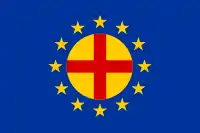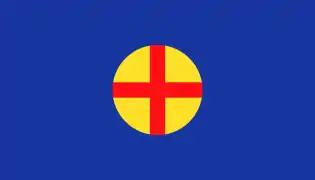Paneuropean Union
The International Paneuropean Union, also referred to as the Paneuropean Movement and the Pan-Europa Movement, is the oldest European unification movement. It began with the publishing of Count Richard von Coudenhove-Kalergi's manifesto Paneuropa (1923), which presented the idea of a unified European State. Coudenhove-Kalergi, a member of the Bohemian Coudenhove-Kalergi family and the son of an Austro-Hungarian diplomat and a Japanese mother, was the organisation's central figure and President until his death in 1972.
 The stars from the Flag of Europe have in recent years been added to the Paneuropean flag.[1] | |
 original flag (1922) | |
| Formation | 1923 |
|---|---|
| Type | European unification movement |
| Headquarters | Strasbourg |
| Location | |
President | Alain Terrenoire (2004– ) |
| Website | www |
It is independent of all political parties, but has a set of four basic principles by which it appraises politicians, parties, and institutions: liberal conservatism, Christianity, social responsibility, and pro-Europeanism.
Members
The Paneuropean Union is one of the largest European organizations and in 2020 has member organizations in[2]
History
The organisation was prohibited by Nazi Germany in 1933, and was founded again after the Second World War. Otto von Habsburg, the head of the Habsburg dynasty and former Crown Prince of Austria-Hungary, became involved with the Paneuropean Union in the 1930s, was elected its Vice President in 1957 and became its International President in 1973, after Coudenhove's death. The President of the Union since 2004 is Alain Terrenoire, former Member of Parliament in France and MEP and Director of the French Paneuropa-Union. Otto Habsburg became the International Honorary President of the International Paneuropean Union in 2004. Its Vice President is Walburga Habsburg Douglas, a member of the Swedish Parliament.
The Union has branches in many European countries, with the General Secretariat located in Munich. In France, the Pan-Europa Union was founded by later President Georges Pompidou and later cabinet minister Louis Terrenoire, with the support of Charles de Gaulle. The Union achieved high political influence in France, particularly within the Gaullist segment of French politics.

Winston Churchill lauded the movement's work for a unified Europe prior to the war in his famous Zurich speech in 1946.[3][4]
In 1947, the group formed around Duncan Sandys, Winston Churchill, Edvard Beneš and others split into newly formed European Movement in opposition of the Union's strong Christian right.
Grounded in liberal values, the Paneuropean Union was considered staunchly anti-communist from its inception and especially during the Cold War. For this reason, the organisation was much reviled by the communist regimes of the Eastern Bloc. The organisation became renowned for its role in organising the Pan-European Picnic, an important event during the Revolutions of 1989.
Presidents

- Count Richard von Coudenhove-Kalergi (1923–1972), elected the first International President in 1926.
- Otto von Habsburg, MEP, the former Crown Prince Otto of Austria-Hungary (1973–2004)
- Alain Terrenoire, former Member of Parliament and MEP, France (2004–)
Members
The Paneuropean Union lists the following as historical members:[5][6]
- Konrad Adenauer
- Raymond Barre
- Léon Blum
- Aristide Briand
- Paul Claudel
- Benedetto Croce
- Albert Einstein
- Sigmund Freud
- Ortega y Gasset
- Charles de Gaulle
- Alfons Goppel
- Otto von Habsburg
- Gerhart Hauptmann
- Bronisław Huberman
- Bruno Kreisky
- Paul Löbe
- Salvador de Madariaga
- Heinrich Mann
- Thomas Mann
- Johan Ludwig Mowinckel
- Fridtjof Nansen
- Georges Pompidou
- Rainer Maria Rilke
- Arthur Schnitzler
- Kurt Schuschnigg
- Franz Josef Strauß
- Richard Strauss
- Gustav Stresemann
- Paul Valéry
- Franz Werfel
- Stefan Zweig
See also
- Pan-European identity
- European integration – mainly through the European Union and the Council of Europe
- Euroscepticism – opposition to the process of political European integration
References
- This flag variant was displayed at the funeral procession for Otto of Habsburg in 2011.
- Paneuropa - Member Organisations, 13 May 2020.
- Michael Gehler; Wolfram Kaiser, Helmut Wohnout: Christdemokratie in Europa im 20. Jahrhundert: Christian democracy in 20th century Europe. Böhlau Verlag Wien, 2001, ISBN 3205993608, Seiten 595.
- Trevor C. Salmon; William Nicoll: Building European Union: a documentary history and analysis. Manchester University Press, 1997, ISBN 0719044464, Seite 26.
- Richard Vaughan, Twentieth-Century Europe: Paths to Unity, Taylor & Francis, 1979, ISBN 0064971724
- Pan-Europa – The parent idea of a united Europe, 13 May 2020.
External links
| Wikimedia Commons has media related to Paneuropean Union. |
- Official website
- European Society Coudenhove-Kalergi
- Archival sources on the Paneuropean Union at the Historical Archives of the EU in
- Pan-Europa by Richard N. Coudenhove-Kalergi
